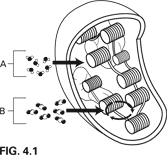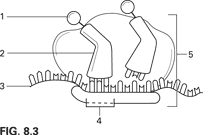protein synthesis
Scientists use observations and data to form and test ________.
hypotheses.
Atoms in molecules share pairs of electrons when they make __________.
covalent bonds.
What molecule carries chemical energy that cells use for their functions?
ATP
The main difference between the four nucleotides that make up DNA is that they have different?
bases.
How many people can Earth support?
an unknown number
Which nutrient is required for nearly every chemical reaction in every cell in your body?
Water, H2O
During an experiment, which factors are observed and measured?
dependent variables
The four main types of carbon-based molecules in organisms are carbohydrates, lipids, nucleic acids, and ________.
proteins.
What happens to the sugars that are made during photosynthesis?
They can be used for cellular respiration.
Figure 8.1 shows a single strand of DNA. Name the first three nucleotides of the other DNA strand.

GGC
Why are frogs sensitive to pollutants in water?
They have water-soluble skins.
What nutrient is your body's main source of energy?
carbohydrates
What is a phrase or fact that best describes scientific theories?
are never proven
What is formed when an atom gains or loses electrons
Where in plant cells are the energy-absorbing molecules for photosynthesis located?
thylakoids
During replication, the function of the enzyme DNA polymerase is to _____.
bind nucleotides together.
The pH of normal rain is?
5.6
Suppose you were eating an apple. Digestion of the apple would begin in your _____.
mouth.
All the chemical processes used to build up or break down materials are called an organism's ________.
metabolism.
Both animal fats and plant oils are made up of glycerol and ___________.
fatty acids.
The water molecules labeled A in Figure 4.1 are going to the thylakoids to take part in which process?

light-dependent reactions

What process is shown?
translation
Which level of the food chain is most affected by biomagnification?
tertiary consumers
What function is performed by the liver?
produces bile

Identify the independent variable, dependent variable, and 3 constants in the above data from an experiment.
independent variable: soil
dependent variable: plant height
constants: location, seed type, water amount, pot style/size
Chemical reactions that absorb more energy than they release are called?
endothermic.
Which process is best represented by the following chemical equation?
sugars + oxygen ![]() carbon dioxide + water
carbon dioxide + water
cellular respiration
What is the term for the sections of messenger RNA that are spliced together during processing?
exons
An ecological footprint is a calculation of the land used by an individual to meet all his or her needs. Name two factors that would go into the calculation.
food, water, shelter, energy, or waste production
What is the term for the millions of blood-filtering units inside the kidney?
nephrons